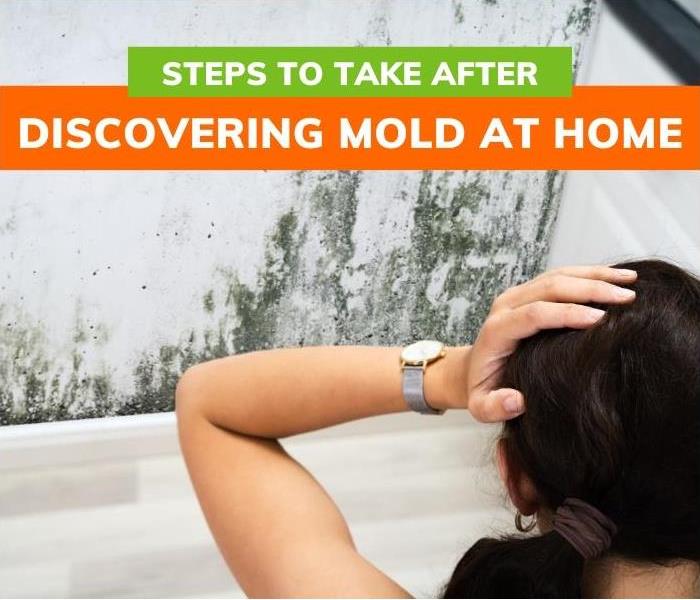Steps to Take After Discovering Mold at Home
3/14/2025 (Permalink)
Steps to Take After Discovering Mold at Home
Discovering mold in your home can be distressing, but addressing it promptly and methodically can help prevent additional damage and risks to your family's health. Mold conditions become manageable by identifying the cause, limiting the spread, and using safe cleaning methods. A proactive approach to locating and treating mold infestations ensures a healthier home environment for the entire family.
Calmly Assess the Situation
Discovering mold in the home can be anxiety-provoking, but remaining calm makes it easier to handle the problem methodically. Without touching the mold, inspect the infected area to see the extent of mold growth and whether moisture is present. Before deciding on steps to take after discovering mold at home, determine if the infestation is limited to one section or has spread across several areas.
Conduct a “sniff” test to detect musty odors. This smell often indicates hidden mold, such as underneath carpets or behind furniture. Consider potential causes in the structure, such as flooding, leaks, or high humidity. Avoid disturbing the areas as much as possible to prevent microscopic mold spores from becoming airborne and spreading.
Locate Moisture Sources
Mold thrives in damp areas and humid conditions. Finding the source of moisture is vital to preventing further growth. Inspect the building, looking for plumbing leaks or water entry points in window frames or doors. If the building was involved in a fire, the fire damage cleanup might include removing excess moisture and mold. Examine the ceiling and walls, looking for stains indicating water leaks through the roof or inside the walls. Additionally, check the flooring for signs of warping.
Look for signs of mold damage in areas with frequent condensation, such as kitchens and bathrooms. Use a moisture meter tool to detect hidden moisture in walls, ceilings, and small areas such as crawl spaces. Address ongoing moisture issues, such as water leaks, before tackling the mold cleanup.
Limit Spore Spread
Mold spreads through invisible spores that float through the air, requiring careful handling to reduce the risk of further contamination. Avoid using the HVAC system or fans until the mold is safely contained. Cover vents and keep doors shut to close off the affected area. To seal the area off, use plastic sheeting taped to walls and ceilings for heavily contaminated spaces.
To prevent disturbing and releasing mold spores, minimize the movement of materials in the affected area. When handling moldy materials, wear protective masks, gloves, and other gear.
Assess the Severity
Mold problems do not always need professional remediation, but surveying the extent of the problem helps determine the next steps to take after discovering mold at home. Estimate the square footage of the affected area. Small building sections, such as 10 square feet or less, are often manageable with DIY cleaning solutions.
Larger areas of mold growth or those that have worsened to the point of affecting structural elements may need professional intervention. If the mold appears toxic, it is usually best to leave the job to professionals.
Take Health and Safety Precautions
Exposure to airborne mold spores in the home can trigger allergic reactions, respiratory issues, and physical discomfort, so it is essential to take protective precautions. Wear an N95 mask to prevent inhalation of mold spores. Minimize skin contact by wearing long sleeves and using gloves.
Keep sensitive people, such as children, elderly individuals, and those with respiratory conditions, away from infected rooms. Ventilate the areas, especially when using cleaning solutions. Wash hands and clothing thoroughly after handling materials or items contaminated by mold.
Use Safe DIY Mold Cleaning Methods
For minor problem areas, the proper steps after discovering mold at home can eliminate mold without spreading spores. Avoid using bleach solutions on porous materials such as wallboard, carpeting, and furniture because it will not reach the roots to completely kill the mold. Instead, use a specialized mold cleaner or a non-ammonia detergent.
Scrub the affected surfaces gently to avoid releasing mold spores into the air. Infected materials that cannot be adequately cleaned should be appropriately discarded to prevent a repeat mold infestation. To discourage regrowth, dry the cleaned-up area and address the issues that initially created the excessive moisture.
When DIY Is Not Enough
Sometimes, mold situations require more in-depth assessment and treatment to ensure the infestation is removed entirely and safely. A good guideline is to consider expert assessment and remediation when the affected area is larger than 10 square feet. The mold that has settled inside walls, the building’s air ducts, and hidden or hard-to-reach places like crawl spaces are often difficult to remove without specialized tools and equipment.
If an area has been cleaned but musty odors persist, additional hidden mold is likely. If any household members experience worsening allergies or unexplained health issues, an expert assessment is advised. The building’s air quality may need to be tested to determine the level of contamination.
Address Underlying Causes
Treating affected areas to remove mold is only effective if the source of the problem, moisture, is resolved. Improve ventilation in areas with excess humidity buildup, such as bathrooms. Use HEP air purifiers to capture any remaining mold spores and other allergens to prevent illness and spreading.
Repair leaks in pipes, windows, or roofs immediately. Inspect rain gutters to keep rainwater from pooling and seeping underneath roofing materials and into the home. Keep indoor humidity to 50% or below with the help of dehumidifiers. Consider whether a basement or crawl space requires waterproofing solutions to mitigate moisture-related issues.
Monitor for Recurrence
If moisture remains present, it creates favorable conditions for repeated mold growth, even after cleaning. Routinely inspect previously affected areas for signs of regrowth or moisture. Check basements, bathrooms, and other areas that tend to collect moisture.
Test the humidity levels in the home periodically and promptly address any ongoing problems, such as leaks or condensation. Schedule an inspection if odors or other signs of mold reappear after cleaning.
Take Preventative Action
Proactively handling a mold infestation can help prevent the hassle of dealing with it again in the future. Use mold-resistant paint in high-humidity areas such as kitchens and bathrooms. Ensure rooms have proper insulation to prevent condensation from building up. Store belongings in moisture-proof containers, especially those put away in attics and basements.
Have plumbing, roofing, and HVAC systems inspected regularly for potential mold or leak-related issues. Inform the family living at home of the importance and methods for moisture control.
Make Mold a Thing of the Past
Managing a mold infestation requires identifying the root cause, which is moisture. Even if the mold is cleaned up, without proper mitigation, the mold can come back, damaging your family's home and health. Regular maintenance, such as plumbing inspections, indoor humidity controls, and leak sealing, can help keep mold away for good. Additionally, HVAC system cleaning contributes to improved air quality and prevents the spread of mold spores to other areas of the home. Remain vigilant with the help of the professionals at SERVPRO®. Our experienced staff will help protect you and your loved ones from the threat of mold infestations. Contact us today for more information.






 24/7 Emergency Service
24/7 Emergency Service
